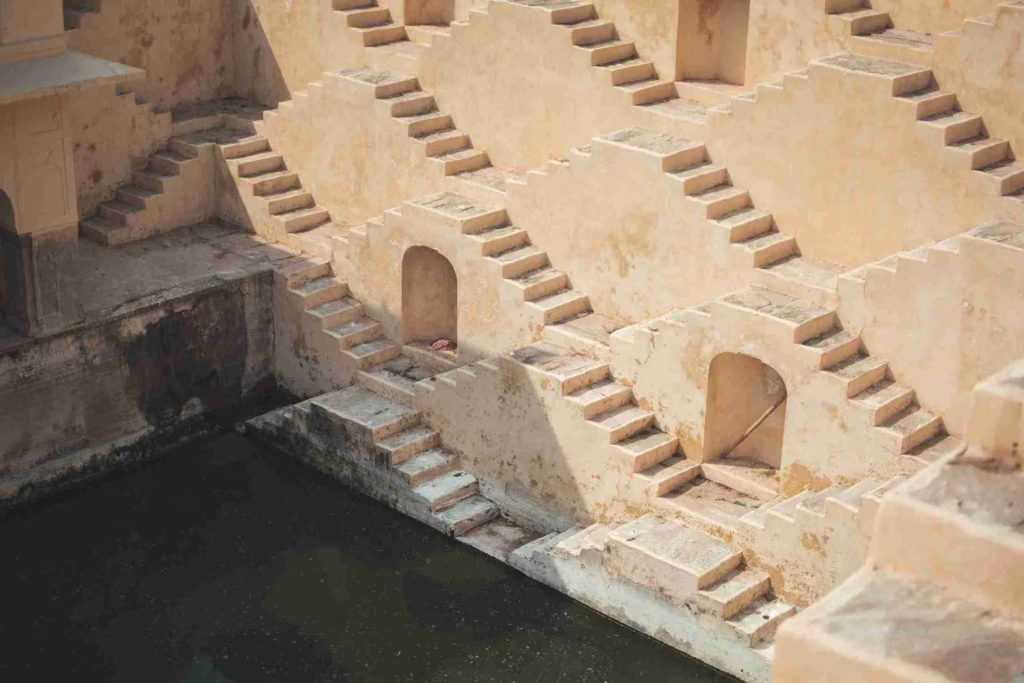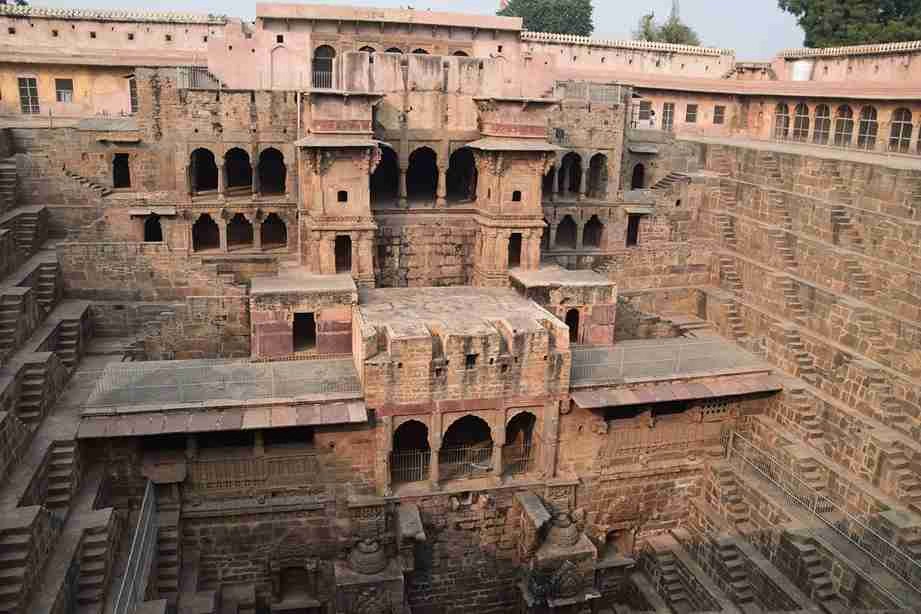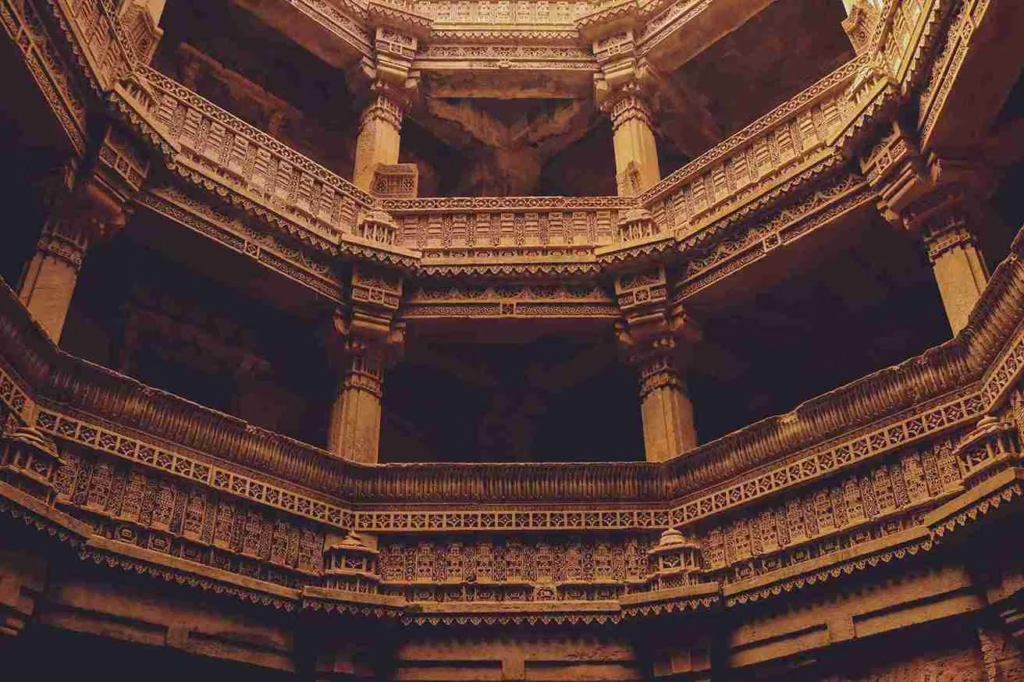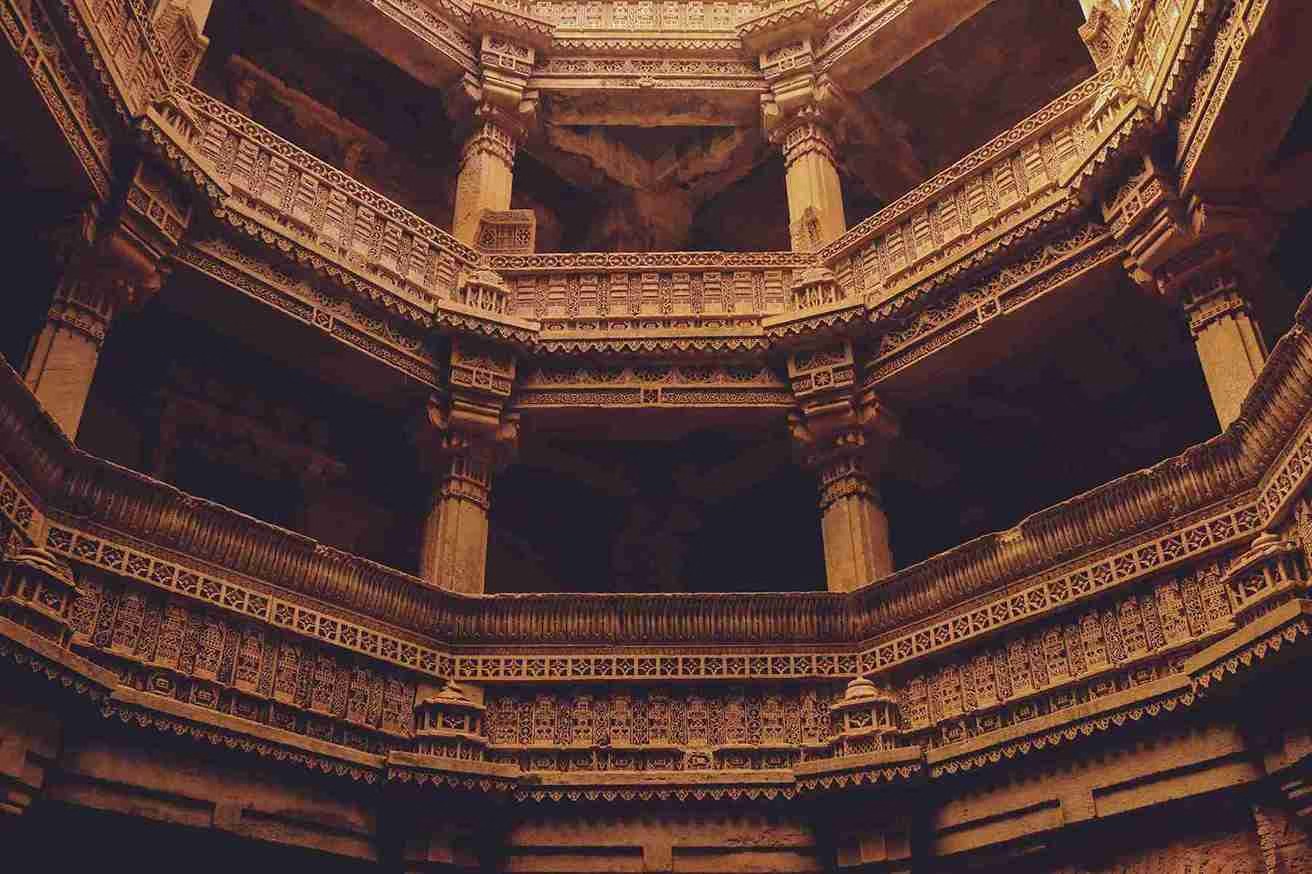Did you know that the famous Chand Baori in Rajasthan, India is one of the largest stepwells in the world? It is featured in several Bollywood movies, including Bhool Bhulaiyya, and Paheli. I bet you were unaware of this and many other significant aspects of step-wells. Don’t worry, because in this blog we will be talking about the art of constructing stepwells in Gujarat and Rajasthan in depth.
Let me break it down into smaller and edible chunks! Kidding! So, what is a step-well? A step well also commonly known as a Vav, Baori, or even Bawdis in India is an architectural marvel, designed like a well with a series of steps leading downwards. In India, one can find many such Baoris and Vavs not just in Rajasthan but also in Gujarat. In fact, some of the very popular Vavs can be spotted in Gujarat, there are around 500 such Vavs there. Some of the most visited and famous ones include the Rani ki Vav, the Adalaj step well, and the Dada Harir Vav.
Now, let’s see how was a step well used, and what features of a step well that make it stand out!

So, a step well is like any other well, but just with a touch of extravagance. It was also used to store water in ancient India. Such step wells were mostly constructed near religious buildings so that it was accessible to the public. Not only this, these step wells were built by the very rich, wealthy or affluent classes to show off their power, and wealth, and as a form to serve society.
Some features that were highly regarded in olden times that actually make step wells a marvel to awe at involve the complex, intricate carvings all over the walls, the step wells used to be multi-storied, for higher water levels. Step wells are a very common sight in the western parts of India, like in Rajasthan and Gujarat. However, step wells are also found in Pakistan. Stepwell carvings in parts of India such as Gujarat or Rajasthan are a testament to the country’s rich cultural and architectural heritage, however, with time the essence and art of such stepwell carvings is getting faded. What is the History of Stepwells in Gujarat and Rajasthan?
Now that we know what are stepwells, let us also learn about the history and origin of such an architectural marvel.
Stepwells, as discussed above, are also known as Vavs and Baoris in the common Indian language. The construction of such stepwells began in the Indus Valley Civilization, which was said to be one of the largest and most advanced human civilizations to ever have existed. The shreds of evidence may help us to understand the evolution of stepwells. These evidences were discovered at sites like Dholavira, and Mohenjo-Daro.
Have you noticed that these stepwells were very common in arid regions like today’s Gujarat, Rajasthan, and even in parts of Pakistan? The main purpose of building such stepwells in ancient was to particularly manage water during rainfall. This was done to store water for using it all year round without any hassle, just like we have rainwater harvesting these days. Brilliant, isn’t it?
Let’s see what was the role of these stepwells in Gujarat and Rajasthan. So, these stepwells were built with the primary function of storing and using water, as discussed above. Next, due to the design of the structure of stepwells that consisted of steps, it could easily be used as a seating space, hence, making it a place for community gatherings, especially for women. The stepwells were also cool and covered with boundary walls, providing a shade to rest for travellers and a respite from the heat during summers.
In its developing or early stages, stepwells were not as complex as they seem today. Rather, they were built like canals containing a flight of stairs leading downwards to the water level. Gradually, these stepwells evolved into a multiplex design with serpentine and convoluted carvings, a fusion of art and architecture.
Likewise, during the medieval period that lasted from around the 11th to the 13th century, the construction of stepwells in Gujarat and Rajasthan was at its prime. With the rise of the Chaulukya dynasty, stepwells in Gujarat had now become a symbol of status, power, and art. It was also influenced by the Islamic style of architecture, giving it a pavilion structure and miniature carvings with elaborate details.

The emergence of the Mughal rulers in the 14th-15th century also saw heightened patronage towards all forms of art and architecture, including the construction of Baoris or Vavs. Thus, spreading such a classic form all over India, also led to the construction of Pushkarinis (stepwells) in Karnataka, Delhi, Madhya Pradesh, and other regions. The stepwells built in these states and cities were not necessarily built during the Mughal era, however, their patronage played a significant role in the evolution of stepwells from merely a well into spectacular architectural monuments.
Nonetheless, as glorious as it may seem, the symbol of India’s cultural and architectural heritage lost its glory and declined with the arrival of British rule in India. During the 18th century, with the British came a ton of machines and advanced technological equipment, that was meant to store water. These pieces of equipment comprised pipes, pumps, taps, etc. which led to a decrease in the use of stepwells.
What Are the Characteristics of Stepwells in Gujarat and Rajasthan?
The stepwells in Gujarat and Rajasthan showcase the rich history of the country. There has to be something striking to catch the attention of millions of people, right? Let’s unravel the secret to the popularity of the stepwells in India.
Some of the primary features of stepwells involve intricate carvings and sculptures. The pillars, steps and columns, all such structures had different kinds of designs including some geometric shapes, and symmetrical designs similar to a mandala, sculptures of Hindu divinities and other human figures doing actions, dancing, singing, or even at times sleeping. All of these minute details weave a tapestry of art and tell a story that not many can decipher!
The designs and patterns of the stepwells in Gujarat and Rajasthan can be recognised to be a confluence of diverse cultures such as Hinduism, Jainism, and Islam. These patterns and designs were based on themes such as religion religious practices, and spiritual beliefs, often depicting representations of yajna, gods, etc., flower-patterned motifs, the structure of the stepwells was elaborate and had nearly two and sometimes even three storeys.
The intersection of dissimilar art and architectural styles demonstrates the genius of the craftsmen and the originality as well as creativity of Indian architecture.
Coming to the next most integral segment of the construction of stepwells in Gujarat and Rajasthan. What were the techniques employed for the carvings? Some techniques that were used in stepwell carvings involve different carving methods. Before we get to the techniques it is also important for us to know what kind of material was used for its construction. Almost every stepwell in Gujarat and Rajasthan was built using sandstone, because it was not only strong and durable, but was also versatile, and moderately hard, allowing a neat carving. Apart from sandstone, the stepwells also consisted of stucco, mortar, laminar stones, etc. and were sturdily and built to withstand natural calamities.
The stepwells in Gujarat and other states were built in a way that the flight of stairs could be descended to reach the level of water and also at times the steps got covered with water when the water level increased. It also had a passive cooling system that allowed the water and the surrounding area to cool down easily during hot afternoons. And as far as the carvings are concerned, it is the skill of the craftsmen whose hard work had gained a concrete form in the sculptures and chiseling. They used gear and provisions like hammers, chisels, carving knives, mallets, axes, etc.
What Are Some Notable Examples of Stepwells in Gujarat and Rajasthan?
Some of the most famous and well-known stepwells in Gujarat and Rajasthan are the Chand Baori, Rani ki Vav, and Adalaj Stepwell. Let’s see what makes them unique and attractive!
The Chand Baori, a very celebrated 13-storied stepwell in the Abhaneri village of Rajasthan, India, is managed and looked after by the Archaeological Survey of India. It is said to be one of the deepest and largest stepwells around the globe, with a depth of around 62 feet, and 3,500 steps. King Chanda of the Nikumbh dynasty is said to have had it constructed in the 8th century as an offering or dedication to the Hindu Goddess Harshat Mata, who is a symbol of happiness.
The Chand Baori is structured like an inverted pyramid that descends into a prism instead of rising into one. Each one of the steps is arranged carefully to create a symmetrical geometric pattern. This stepwell also had a separate residence for the royals, particularly for the king and the queen. It is also unique in a way because it consists of a stage that was perhaps set up for the public to watch performing arts, along with open verandahs on all four sides. The Chand Baori also holds cinematic value and significance and can be seen making a cameo in not only Bollywood films such as Bhool Bhulaiyaa but also in Hollywood films like The Dark Knight.

The next most popular stepwell on our list would be the Rani ki Vav. The Rani ki Vav also known as the Queen’s Stepwell, was declared a UNESCO World Heritage Site in the year 2014 is situated in the city of Patan in Gujarat, India. It is said to have been built in the year 1063 by Queen Udayamati from the Chaulukya dynasty to commemorate her husband, King Bhimdev the First. Its extravagance and glory were buried deep under muck and slush for over half a dozen centuries after the disappearance of the Saraswati River. And was only recently rediscovered somewhere around the 1940s.
Some of the unique features of the Rani ki Vav include its striking shape which seems like an inverted temple, there are also more than 800 different kinds of sculptures carefully carved that portray the ten avatars of Vishnu, then there are also pillars that are carved in knotty and entangled designs along with geometric patterns. The upper part of the pillars consists of sculptures of women carved beautifully, along with other religious and mythological ones.

Last but not the least! We have the Adalaj Ni Vav or the Adalaj Stepwell in Gujarat’s small town of Adalaj, near Gandhinagar was built in 1499 by Queen Rudabai of the Vaghela dynasty. The construction was started by Rana Veer Singh in 1498, however, the construction had to stop midway due to war and was completed in the year 1499 and also came to be known as Rudabai’s Vav. This stepwell was built during the reign of Mahmud Begada, the then Sultan of Gujarat. Hence, there is a confluence of different architectural styles prevalent during those times, such as a mix of Hindustani and Islamic styles.

Some of the outstanding features of the Adalaj Ni Vav are the five stories of the stepwell along with three grand entrances, the walls depict a different tale altogether with scenes illustrating village life, and the columns are all draped in the elegant and complex labyrinth of designs and patterns, including leaves, flora and fauna found in the region. It also has an octave-like structure with an open ceiling allowing a breath of fresh air and sunlight in. The Adalaj Ni Vav stands as a symbol of love today due to its history.
End Note
So, this blog was all about stepwells and how they were built. I hope this blog has shed some light on your pursuit to gather more information on stepwells in Gujarat and Rajasthan.
Stepwells held a crucial place in the cities of ancient India, especially in the arid and dry areas where storing whenever nature allowed an opportunity was important. It helped the people to have access to water at any time of the year and in any season, they only needed to descend a few steps and voila! They had water.
It also served as an essential source of water for various purposes such as drinking, bathing, cattle, and irrigation to grow crops. It also held religious and social significance as a spot for gatherings, community meetings, and rituals. The structure of the stepwells was such that they provided a cooling effect and offered a break from the hot weather. The stepwells serve as a hallmark of the remarkable and phenomenal architectural skills.
For further reading on the significance of Stepwells, you can visit these useful resources:
Check out our Blog Page on Traditional Indian art.



Leave a Reply